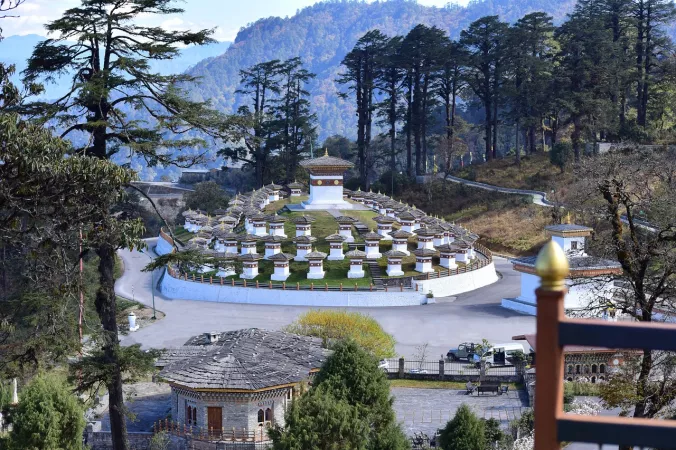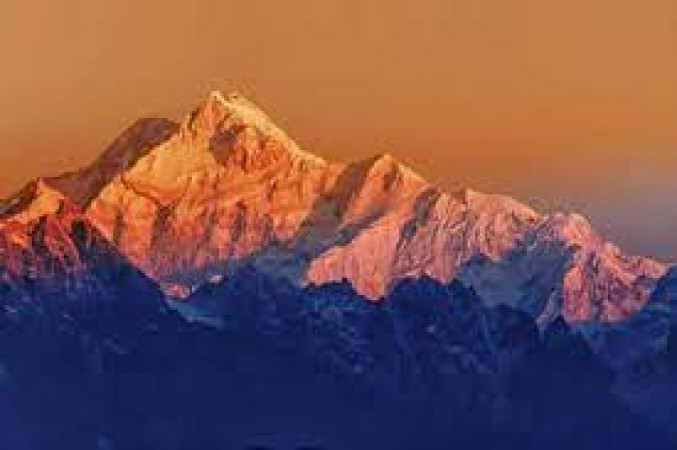Gangtok Travel Guide
Gangtok, the capital city of Sikkim in India, is nestled in the Eastern Himalayas and is renowned for its stunning natural beauty, Buddhist monasteries, and vibrant culture. It is a popular destination for travelers seeking a peaceful retreat amidst the mountains. Gangtok's history is rich, being a former independent kingdom before merging with India in 1975. The city's geography offers breathtaking views of snow-capped peaks, lush valleys, and cascading waterfalls, making it a paradise for nature lovers. Gangtok is also known for its traditional Tibetan architecture, colorful prayer flags, and warm hospitality, making it a unique cultural experience for visitors.Top Attractions in Gangtok
1. Tsomgo Lake 2. Rumtek Monastery 3. Nathula Pass 4. MG Marg 5. Enchey MonasteryGangtok is Famous for
Its serene landscapes and Buddhist monasteries.Top Attractions in Gangtok
- Tsomgo Lake - Rumtek Monastery - Nathula Pass - MG Marg - Enchey MonasteryWhat's Great about Travelling to Gangtok?
- Stunning mountain views - Rich Buddhist culture - Peaceful and serene atmosphere - Adventure activities like trekking and river raftingWhat's Not So Great about Travelling to Gangtok?
- Limited connectivity - High-altitude sickness risk for some travelers - Monsoon season can bring heavy rainfall and landslidesTravel Tips for Gangtok
- Carry valid ID proofs for permits - Dress in layers for changing weather - Respect local customs and traditions - Be cautious while trekking in the mountainsImportant Gangtok trip information
- Ideal Duration: 5-7 days for exploring the city and nearby attractions
- Best Time to Visit: March to May and October to December for pleasant weather
- Nearby Airports and Railway Stations: The nearest airport is Bagdogra Airport, and the closest railway station is New Jalpaiguri Railway Station
Top 10 Places to visit in Gangtok
Per Person
11,900
*EXCLUDING APPLICABLE TAXES 4.8 Ratings
( 37 Reviews )
( 37 Reviews )
Per Person
16,500
*EXCLUDING APPLICABLE TAXES 4.8 Ratings
( 37 Reviews )
( 37 Reviews )
Per Person
11,000
*EXCLUDING APPLICABLE TAXES 5.0 Ratings
( 19 Reviews )
( 19 Reviews )
Total
30,000
*EXCLUDING APPLICABLE TAXES 4.8 Ratings
( 37 Reviews )
( 37 Reviews )
Per Person
24,800
*EXCLUDING APPLICABLE TAXES 4.8 Ratings
( 37 Reviews )
( 37 Reviews )
Per Person
25,500
*EXCLUDING APPLICABLE TAXES 4.8 Ratings
( 37 Reviews )
( 37 Reviews )
FAQ's on Gangtok
Q1: What is the best time to visit Gangtok?
The best time to visit Gangtok is during the months of March to May and October to mid-December. These periods offer pleasant weather with clear skies, making it ideal for sightseeing and outdoor activities. Avoid the monsoon season from June to September as heavy rainfall can disrupt travel plans. Winter months from December to February are cold but perfect for experiencing snowfall and enjoying winter sports in nearby areas.
Q2: Do I need a visa to travel to Gangtok?
Foreign tourists traveling to Gangtok need an Inner Line Permit (ILP) to visit Sikkim. This permit can be obtained online or upon arrival at the entry points. Indian tourists do not require a visa to enter Gangtok but need a valid ID proof. Visitors should check the latest regulations and exceptions before planning their trip.
Q3: What are the must-visit attractions in Gangtok?
Gangtok offers a range of attractions that include the Enchey Monastery, Rumtek Monastery, Tsomgo Lake, Nathula Pass, Tashi View Point, and the Namgyal Institute of Tibetology. Visitors can explore the vibrant MG Marg for shopping and dining experiences, or take a cable car ride for panoramic views of the city. Adventure enthusiasts can go trekking in the Himalayan foothills or indulge in river rafting in the Teesta River.
Q4: Is Gangtok a safe place to travel?
Gangtok is generally a safe destination for travelers. However, it is advisable to take normal precautions like avoiding isolated areas at night and safeguarding personal belongings. Travelers should be cautious while exploring remote areas or trekking trails and follow safety guidelines provided by local authorities. In case of any emergencies, contact the nearest police station or tourist assistance center.
Q5: What is the local currency in Gangtok and can I use credit cards?
The local currency in Gangtok is the Indian Rupee (INR). ATMs are widely available in the city, especially in popular tourist areas. While credit cards are accepted in larger establishments like hotels and restaurants, it is advisable to carry cash for smaller vendors or local markets. Inform your bank about your travel plans to avoid any card-related issues during your stay.
Q6: What is the local cuisine like in Gangtok?
Gangtok offers a diverse culinary experience with a mix of Tibetan, Nepali, and Sikkimese flavors. Must-try dishes include momos (dumplings), thukpa (noodle soup), gundruk (fermented green vegetables), and phagshapa (pork with radish). Vegetarian options like Chhurpi soup and Sael roti are also popular. Visitors can savor these dishes at local eateries, street food stalls, and upscale restaurants. Be mindful of spice levels and inform the server about any dietary restrictions or preferences.
Q7: What transportation options are available in Gangtok?
Transportation in Gangtok includes public buses, taxis, and rented vehicles. Shared taxis and private cabs are common for local commuting and sightseeing. Travelers can also hire motorcycles or bicycles to explore the city at their pace. The city is well-connected by road, and private tour operators offer day trips to nearby attractions. Public buses are budget-friendly but may have limited schedules. Plan your travel in advance and consider the terrain and weather conditions while choosing your mode of transportation.
Q8: Are there any cultural norms or etiquette I should be aware of when visiting Gangtok?
When visiting Gangtok, it is essential to respect the local customs and traditions. Greet locals with a traditional 'Namaste' and dress modestly, especially when visiting religious sites. Avoid public displays of affection and follow photography restrictions at monasteries or sacred places. Seek permission before clicking pictures of individuals or cultural events. Do not litter and dispose of waste responsibly. Participate in local festivals and events with enthusiasm but observe and follow the customs respectfully. Engage with the community members to learn about their culture and heritage, fostering mutual respect and understanding.
Q9: I am a travel agent. How can I buy travel leads of Gangtok?
Register yourself as a travel agent at agents.tripclap.com and then you can buy travel leads to Gangtok once your account is approved. For more details contact our support team at +91-8069186564 or support@tripclap.com







![GANGTOK WITH NORTH SIKKIM - 5N6D-Meal Plan MAP [Based on 5 pax]](https://static.tripclap.com/uploads/package/350X200/1752144628-1752144628-454e.webp)


![Gangtok 3N/4D package (502620) [Based on 2 pax]](https://static.tripclap.com/uploads/package/350X200/1758193103-1758193103-2476e.webp)






